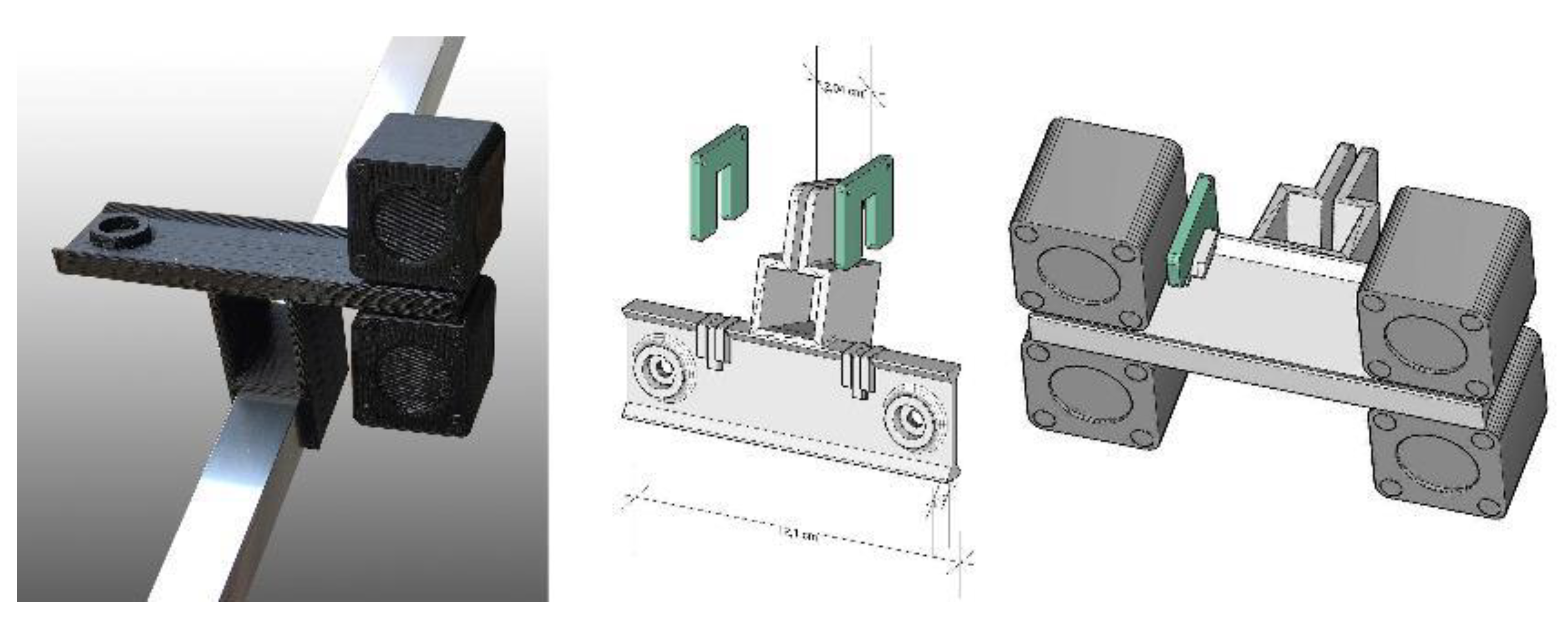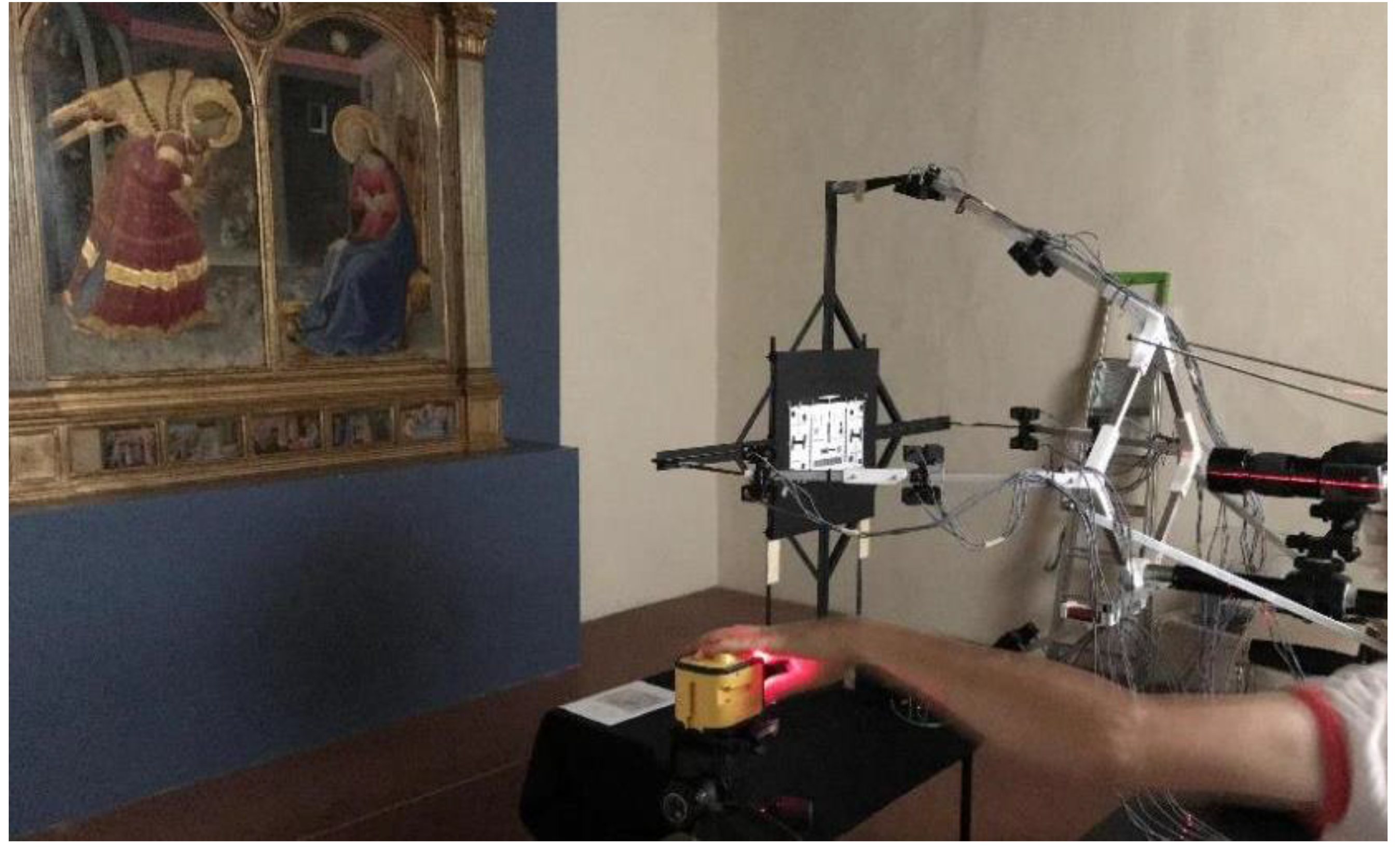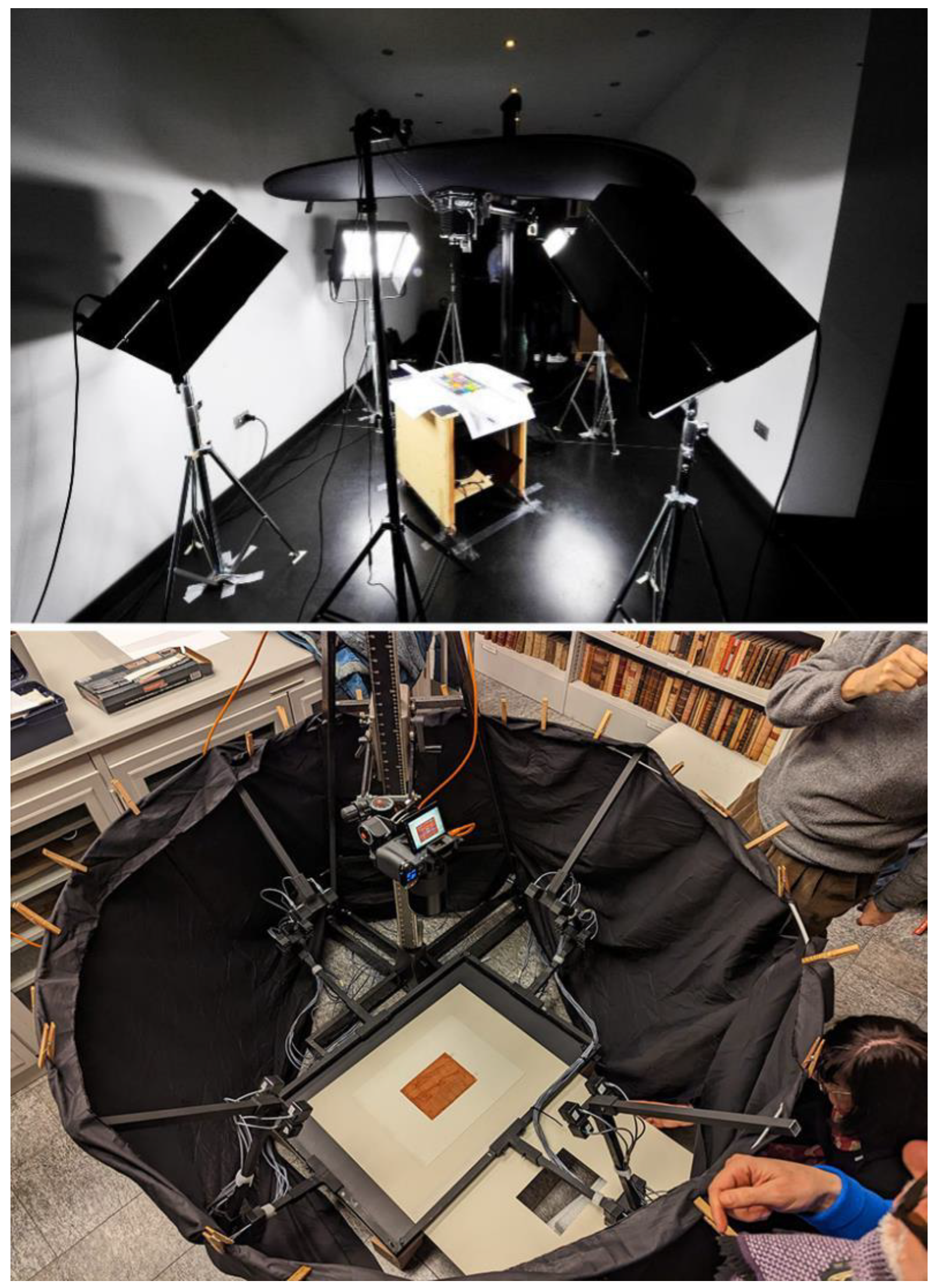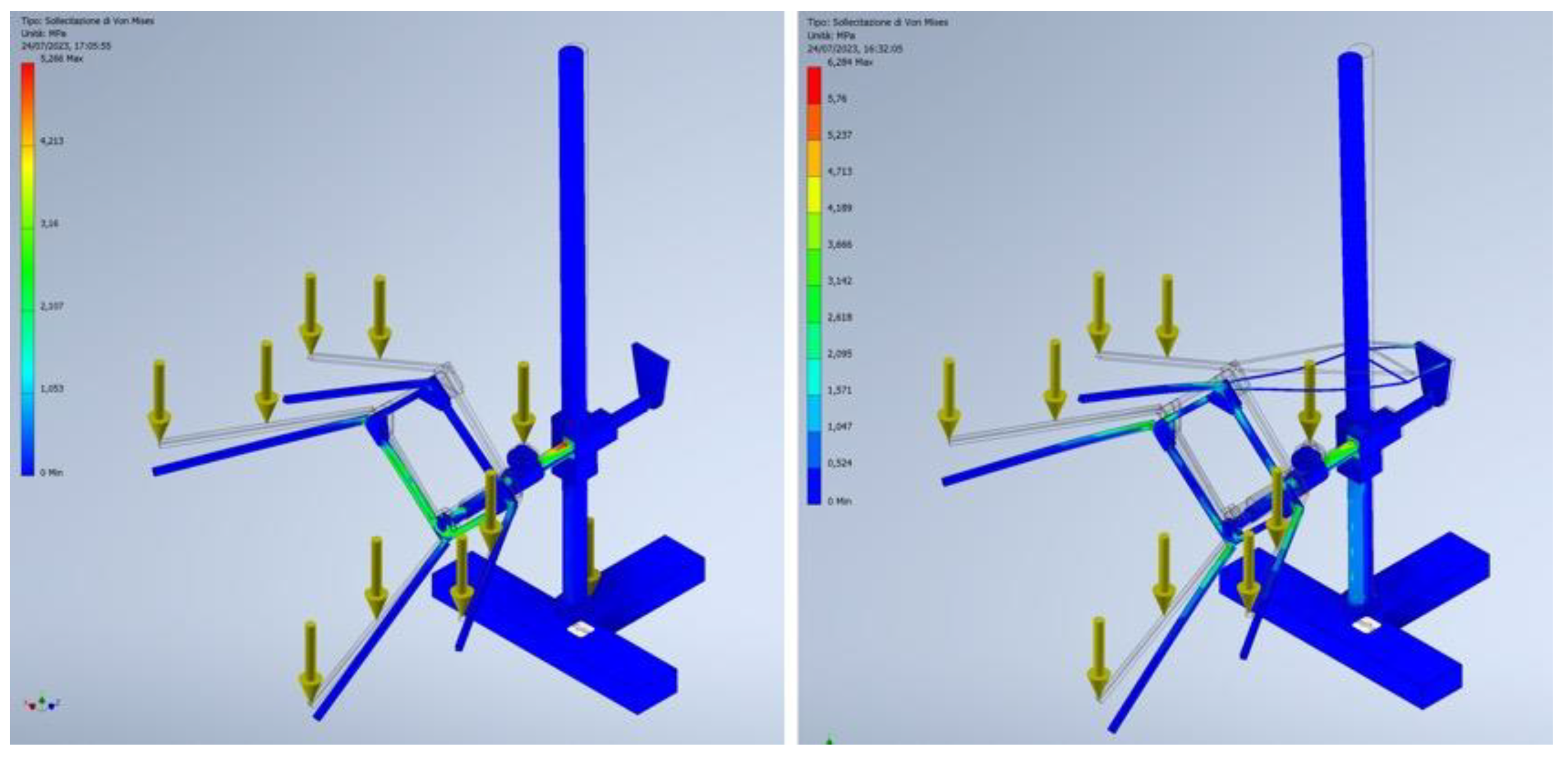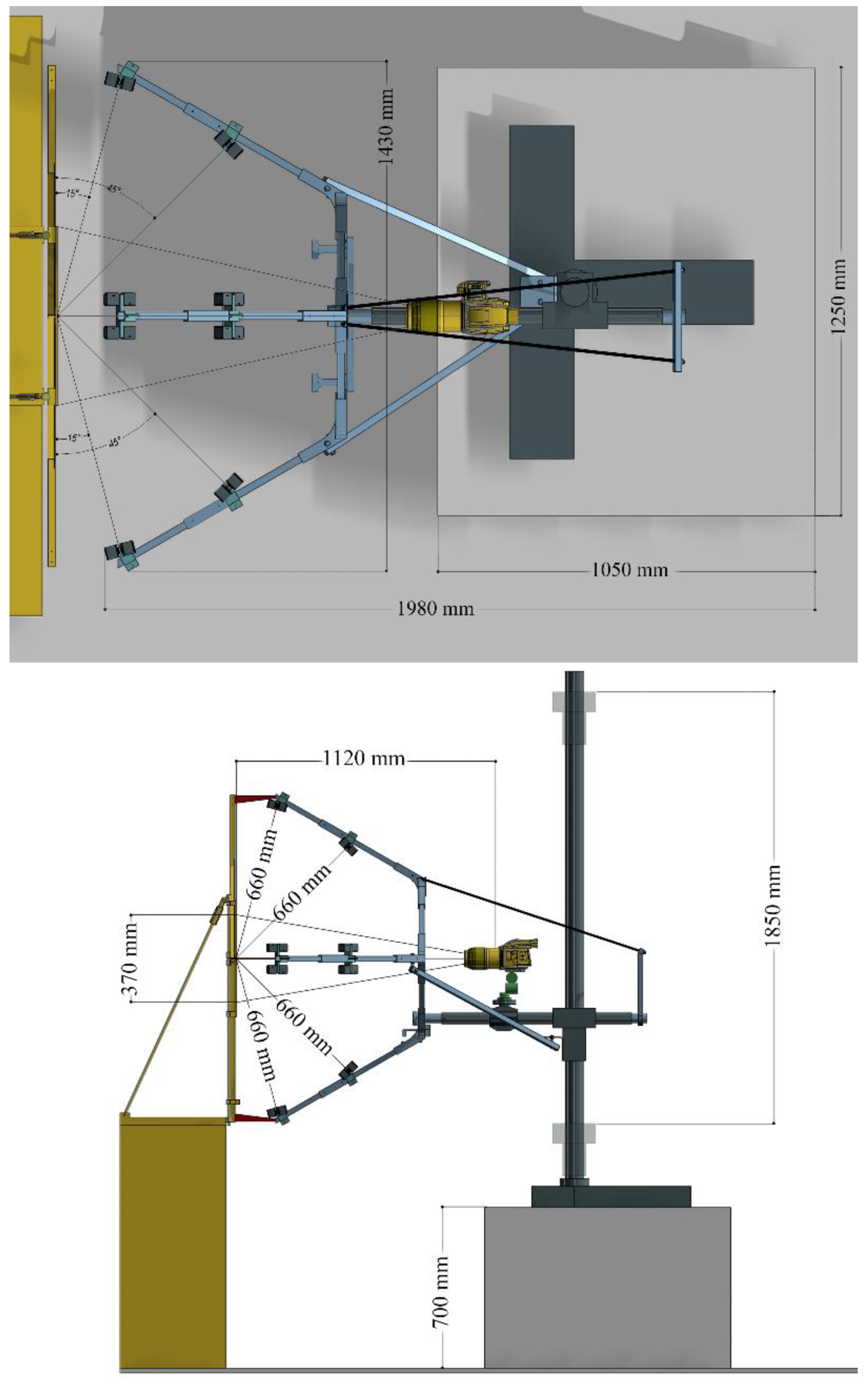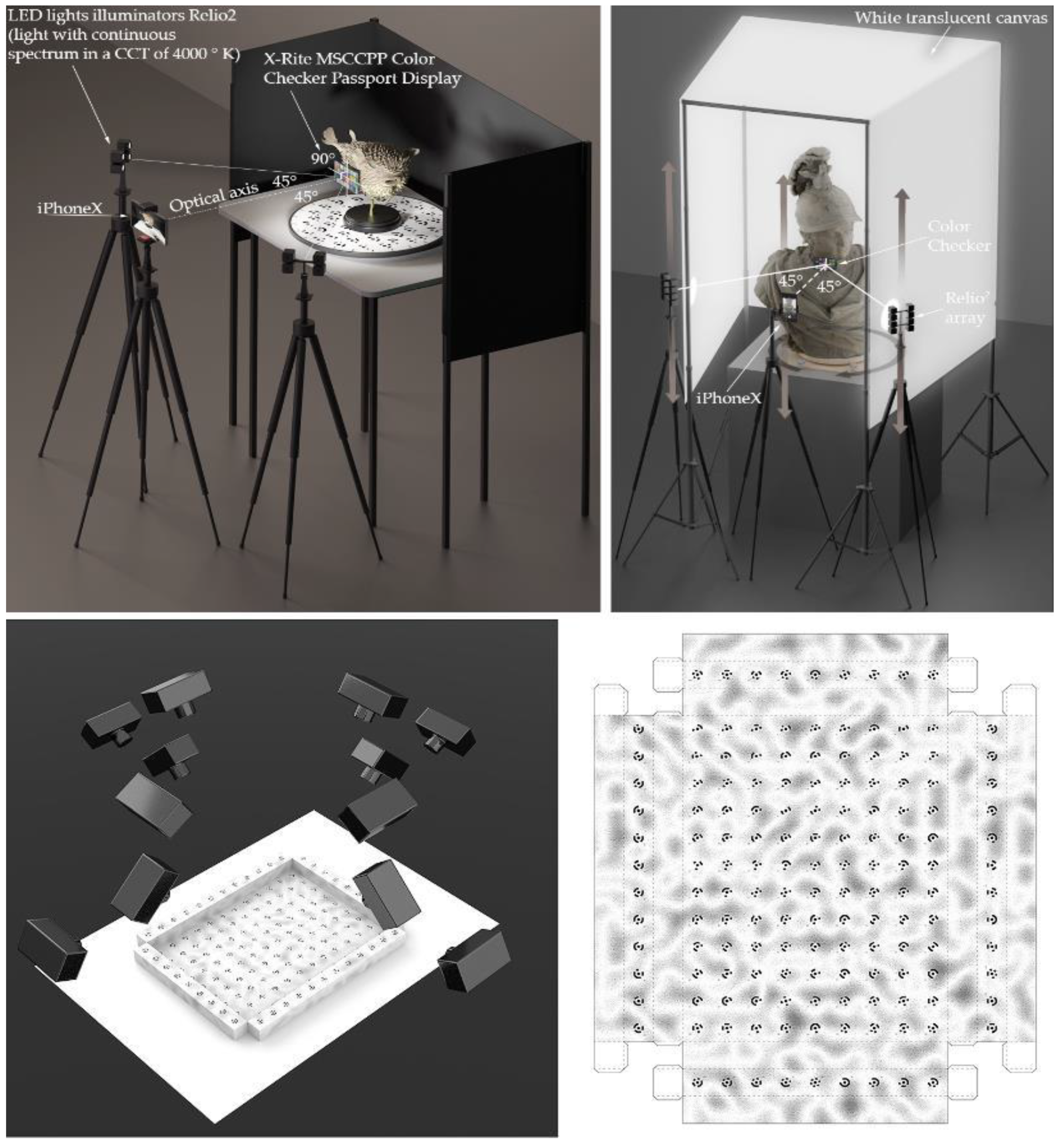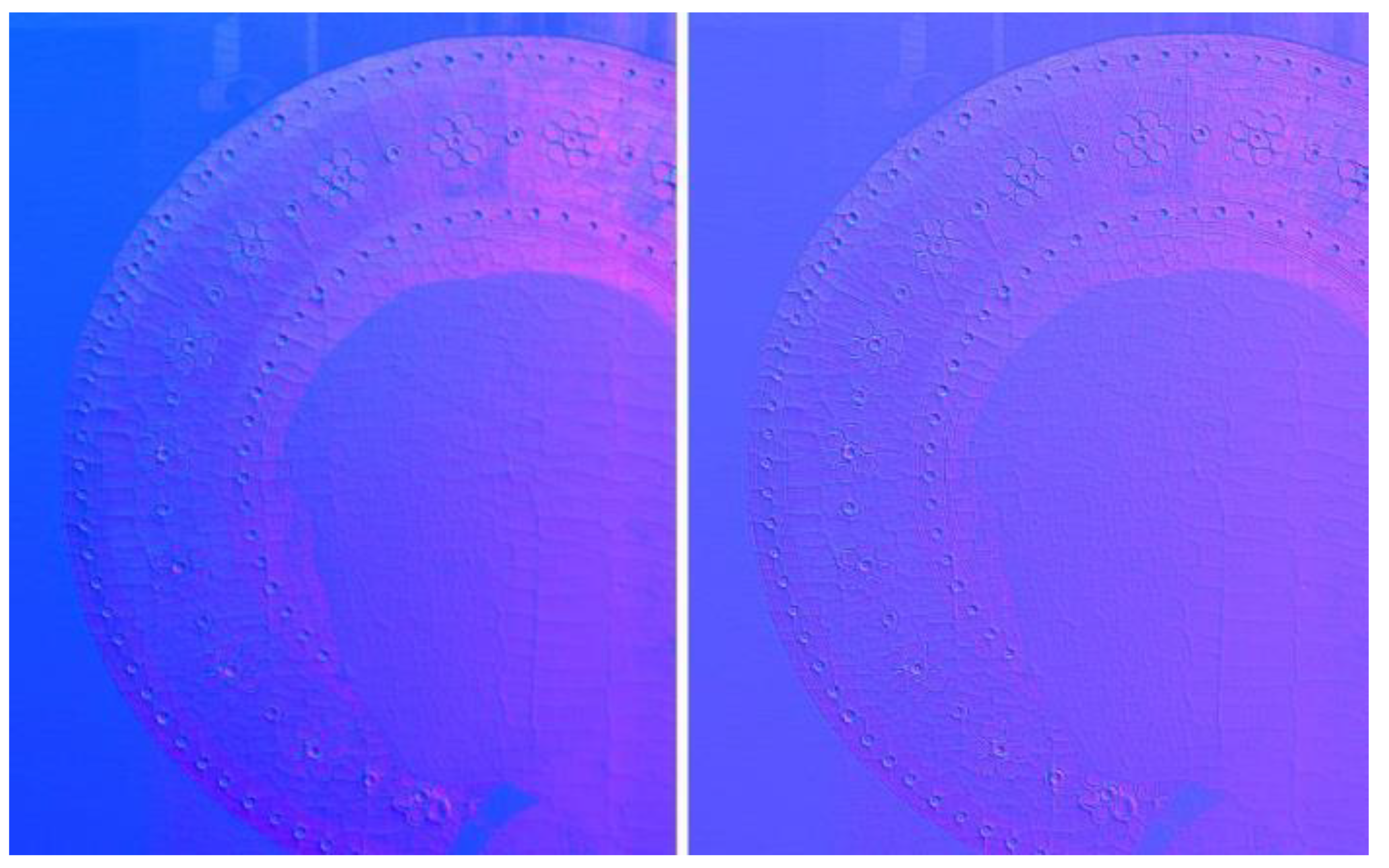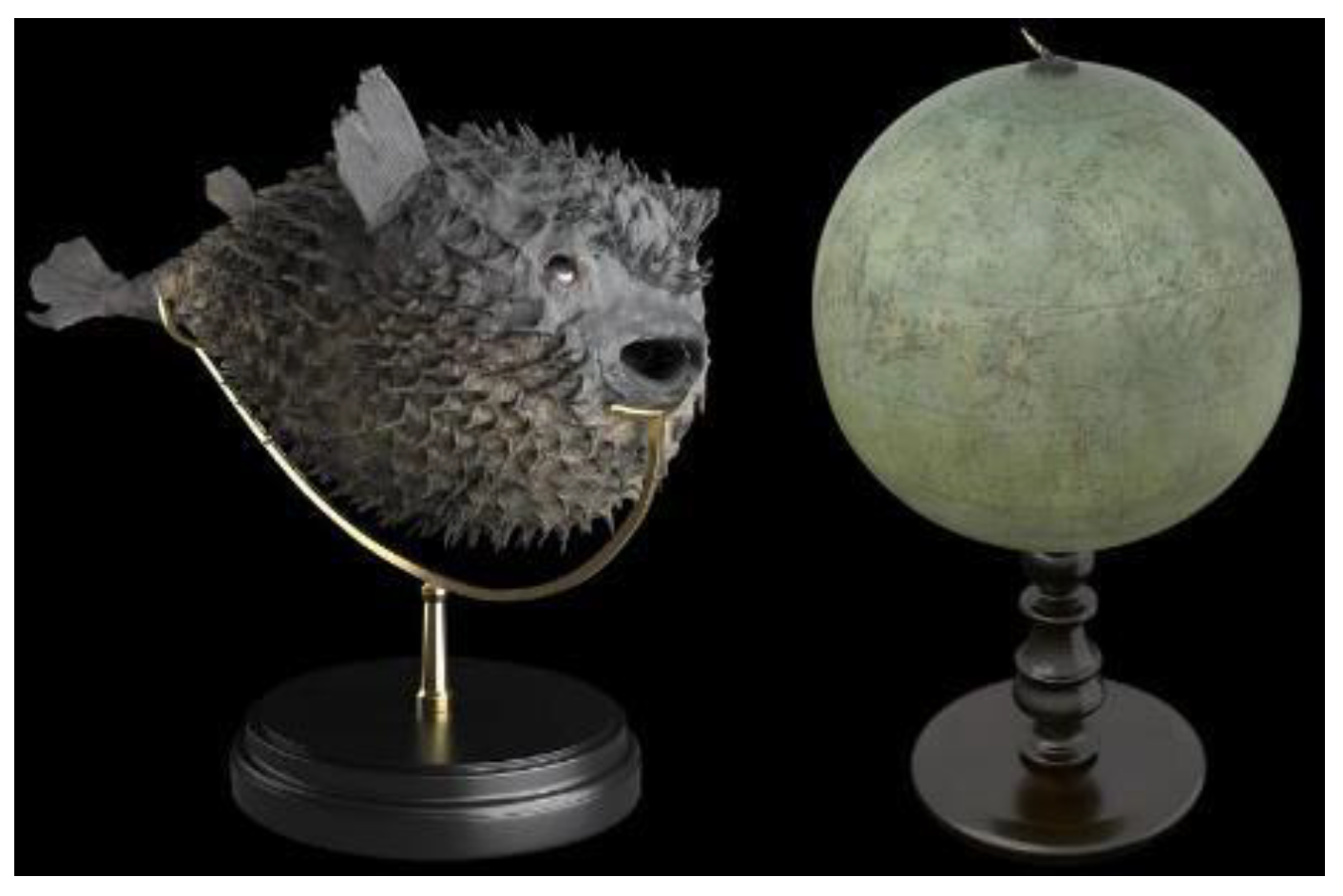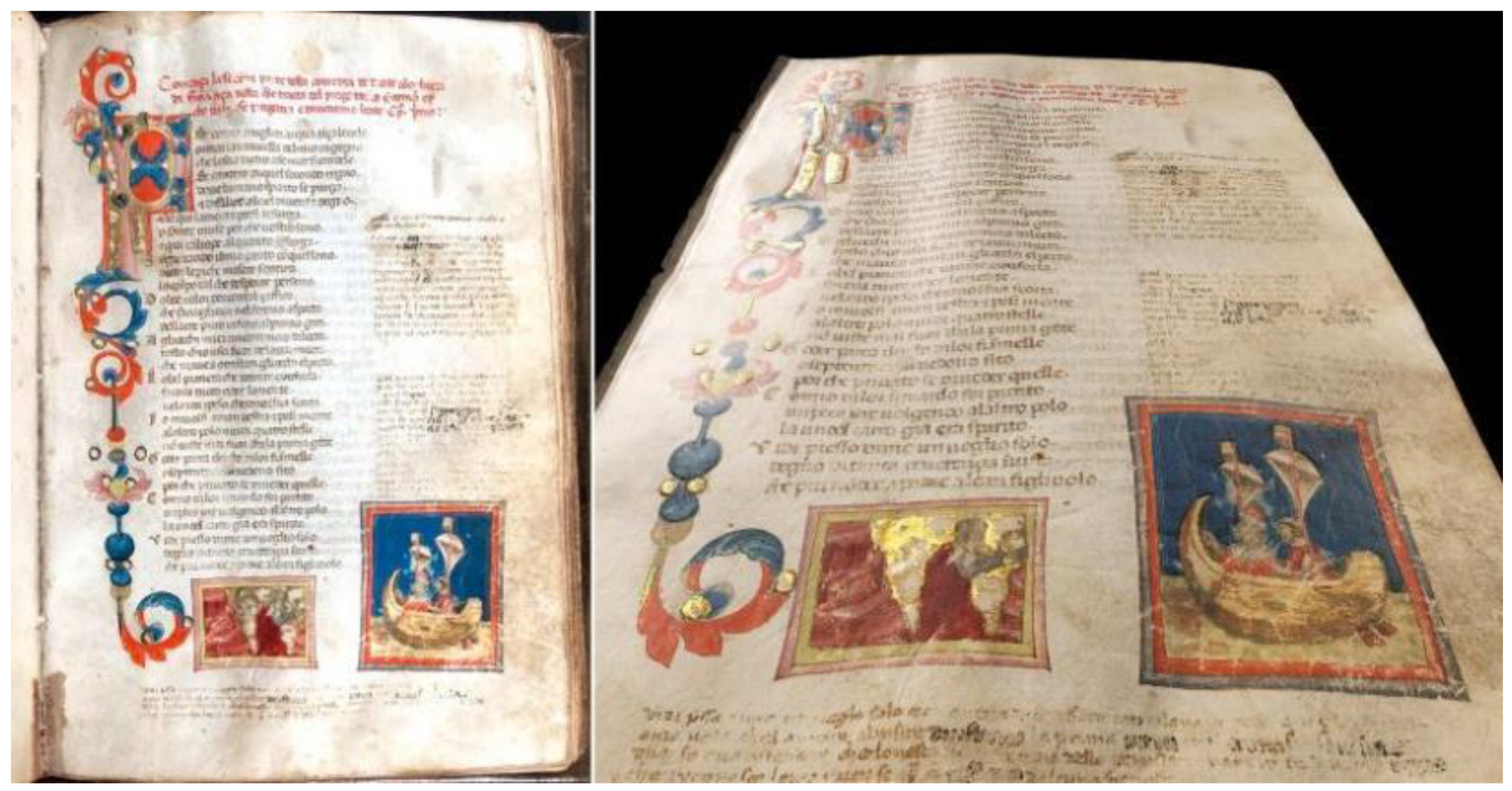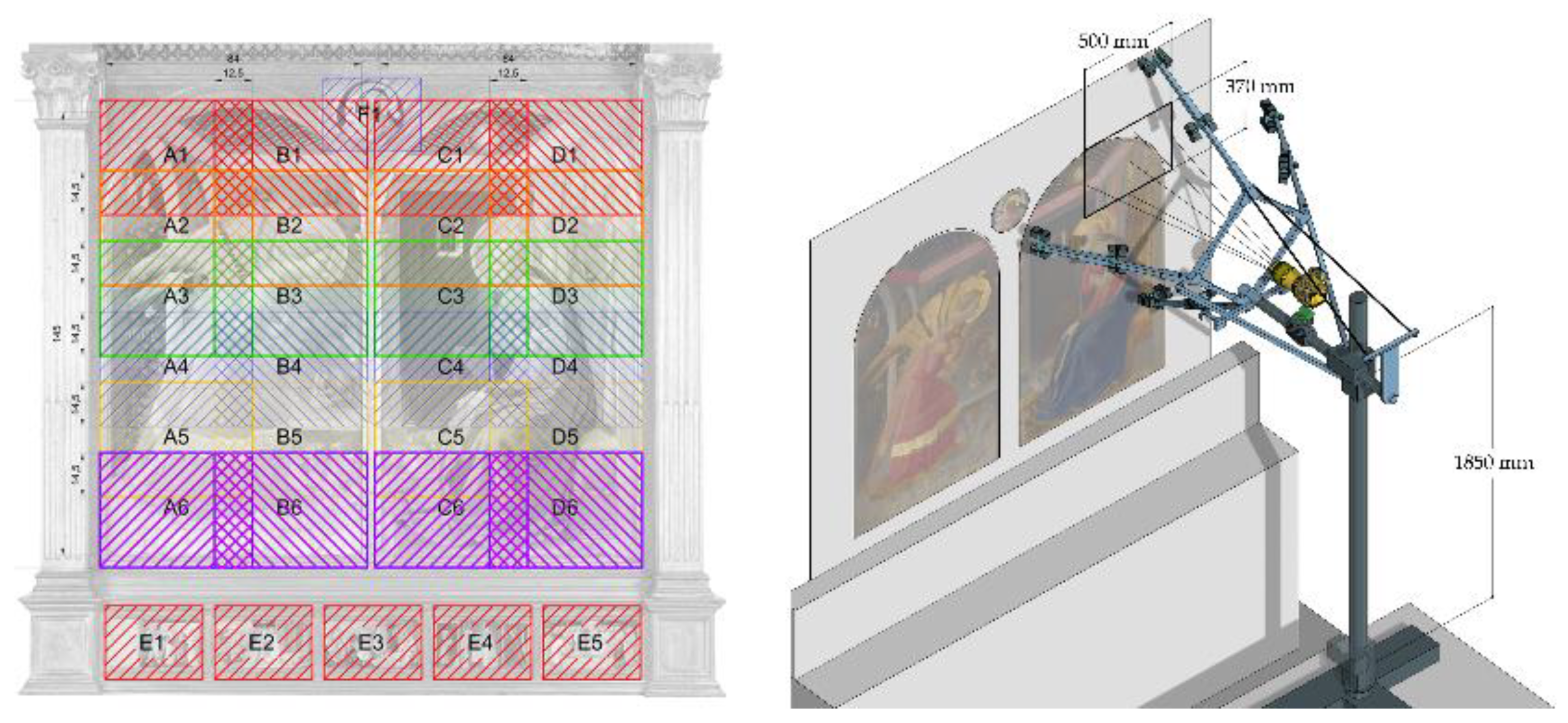1. Introduction
Hardware instruments played a key role in the activities of surveyors, architects, restorers, and other professionals involved in the Cultural Heritage (CH) documentation - particularly in the field of arts and architecture - with the aim of knowledge, conservation, communication, and re-use as design background, even dating back to ancient times. In
Figure 1 is represented a portrait of the Italian architect Andrea Palladio, the author of the most widespread and famous architectural treatise of all time,
The four books of the architecture [
1], and surely one of the major artists of Renaissance around the world. The illustration showcases the architect together with the instruments essential to his craft, illustrating his expertise in selecting and employing them with precision for the purpose of the architectural project and survey.
Despite their operational importance and the extraordinary changes related to the IT introduction, the attention they received in recent time was very limited. The new instruments were generally simply accepted without any critical analysis of their advantages, limits, appropriate use, possibilities of new works and workflows enabling analysis previously impossible to do.
The established new workflows demonstrate minimal innovation within the process in where they are embedded, yielding limited benefits. The results remain experimental rather than creating an extensive accumulation of knowledge.
We can find the same scenario also in the field of the CH survey. The emergence of IT expanded the capabilities of survey equipment, with a growing emphasis on documenting ancient artifacts such as graphic works, paintings, sculptures, and archaeological findings, through the creation of more and more faithful 3D models using digital-based tools (e.g., laser scanners, digital cameras, etc.) employing new processes quickly improving over the years. If dedicated software grew up fostering increasingly advanced automatisms, the hardware backing computer applications changed as well, not only in the many possible ways to use it, but also in methods and techniques to produce it [
2].
However, besides the possibility to capture data for the 3D model construction of the artefacts [
3], the process for reality capture remains unchanged in the need of specialized operators (it’s true that the
platea of operators is enlarged, but surveys dedicated to operations on CH lifecycle are minimally improved and knowledge of their methods and their effective use by CH operators remain a blue-sky desire). IT-based CH reality capture hardware instruments are usually designed for specific tasks and to be easily integrated in the software pipelines (the real novelty).
In this scenario the surveyor continues to rely on specialized specific instruments (e.g., no laser scanner currently exists that can capture objects of varying sizes with the appropriate resolution. The transition from scanning artifacts inscribed in a one-meter cube to objects as large as 100 meters long and 30 meters high, it is necessary to utilize at least three different types of laser scanners) and carry out 3D reality capture operations on the go remains nearly impractical.
On the other hand, well established instruments stayed in use as SLR cameras, which simply replaced the old film with CMOS image sensors, and related accessories (tripods, lamps, stands, etc.). The expansion of the possible uses of the cameras, their portability and their relative low-cost have certainly made it possible to exploit all the advantages of digitization, processes automation, and the use of data in the form of numerical files for non-contact surveying methods, but they have not brought limited advantages only in conducting a survey. On the fly survey requires that you always carry your camera along with your set of lenses and some linear measuring tool (such as a ruler or a metric wheel). High precision surveys require specific and expensive instrumentation such as the
Phase One iXM Camera System [
4]. Even with advancements in technology, the current general workflow still needs a process that closely resembles the traditional, non-digital approach.
To overcome this standoff, it’s nowadays a key point to explore, innovate, evaluate the new instruments, to bound accurately their capabilities, and evaluate accurately their proper utilization, which holds utmost significance for the fields of AH (Architectural Heritage), CH Archaeology, and their related activities. This aspect remains an uncharted objective in present-day research. Some research groups have found, analyzed, and measured the quality of the new instruments in certain uses, e.g., in 3D data capture of artifacts of all shapes and kinds the
3Dom group at the Bruno Kessler Foundation in Trento (Italy) conducted an excellent work of, Italy [
5,
6,
7,
8,
9]. However, these analyses were essentially in the context of the evaluation of the performance of the single instrument and not in the study and verification of its ability to fit into a well-determined pipeline or to allow new workflows and uses. Furthermore, there is little literature on frames, rigs and stands designed for specific digitization techniques and easily replicable (a very isolated example is in [
10]), a limited number of examples concern gigantic solutions (e.g., [
11]), and the major parts of them are linked to topics outside of our interest [
12]. A good number of studies can only be found on rotary table-based solutions for 3D object acquisition, as devices with stepper motors and controllers to drive the movement of the table as, for example, in [
13,
14], but this hardware usually requires complex management and programming skills. In addition, in recent time the scenario of survey instruments is potentially changing, thanks to the emergence of general-purpose versatile tools, usable by any professional or non-professional figure, applicable to various scenarios, enabling new ways of working and new workflows capable of changing the entire operation of reality data capture, either by introducing the possibility of on-the-fly surveys, simplifying the workflow of survey operations, and continuing to ensure qualitatively excellent and metrically accurate results. E.g., smartphones, with their multitude of sensors, i.e., GPS receivers, accelerometers, magnetometers, and gyroscopes, used for positioning, navigation, data recording and transmission could enable also on-the-fly processing and procedures, which were considered impossible to get until a few years ago. In recent years, smartphone camera technology has made formidable improvements regarding sensors quality and software performance, that still improve year after year, supported by flourishing of scientific research in the area. Recent smartphones, such as the
Apple iPhone 14 and the
Huawei Mate 50 Pro, bring levels of image resolution, sharpness, and colour accuracy sometime better than prosumer SLR cameras [
15]. These camera sensors, jointly with adaptable software controls, are a clear example of versatility, as they became eclectically useful across different applications, showcasing the increasing generic nature of adaptable tools in the digital era [
16,
17]. However, the terrific improvement in the last years of smartphone cameras with the new ‘
imaging at our fingertips’ allowing a change in the image documentation role, remains a potential solution. Smartphone cameras are not designed to be light-measuring devices, but to produce visually pleasing photographs exploiting a powerful processing (
photofinishing) applied in the camera hardware. As well known, an aesthetically pleasing image does not serve the purpose of adequately documenting Heritage artifacts, as it lacks the necessary properties for tasks such as analysis, material identification, decay assessment, and evaluation of structural issues. Moreover, the in-camera processing complicates the process of extract the original state of the image (i.e., the RAW state) to use it as light measure. Without any further development for tools, the usefulness of images capture with those devices is limited and it is impossible to solve e.g., color-related problems, a central issue in the CH field [
18].
On the other hand, specific physical accessories such as tripods, rigs and stands started to be easier to build and at lower costs, requiring less and less specialistic skills, and leading to new possibilities in customization and self-production, thanks to the diffusion and affordability of 3D printers. Additive manufacturing started to be adopted not exclusively in the industrial field, to produce prototypes, functional parts, customized products, and even complex geometries that are often difficult or too expensive to achieve with traditional manufacturing methods. 3D printing technology has also revolutionized the creation of hardware frames used to support and host cameras and smartphones for various purposes [
19]. By leveraging their versatility and customization capabilities, most of these 3D printing systems, jointly with standard elements that you can buy in a warehouse retailer, offer a flexible and tailored solution to construct
ad hoc hardware frames. E.g., in the photography-based reality capture this innovative approach not only enhances the functionality and stability of the devices but also enables their precise positioning and alignment necessary to capture images. The potential of generating custom, affordable on demand accessories introduces a transformative aspect to the digital imaging-based workflow [
20,
21]. This expansion extends well beyond existing boundaries, letting us explore innovative approaches for artifact surveys and adopt new methodologies that align with the lifecycle of CH. However, this new scenario, generating time savings, a wider users base, and better CH management, is minimally explored today.
During the last five years, our group [
22] at the Department of Architecture, University of Bologna, experimented a new research path following the idea of developing streamlined workflows to enable real processes to better fill the requirement of the
lifecycle, address unresolved problems, reduce the need for manual, repetitive tasks, and provide cost-effective solutions of the CH using generic instruments, self-produced accessories,
ad hoc software solutions able to overcome the problems related to the use of general purpose devices. By doing so, the accessibility of IT-related techniques is increased, enabling a wider audience of users to benefit from shared procedures and results. This approach led to some novel perspectives in custom-building tools that can host cameras, smartphones, and light sources, enabling the controlled capture of high-quality photos of paintings, drawings, small architectural artifacts, and sculptures. In this paper the approach illustrating the designed and fabricated instruments is illustrated, together with the software allowing their right use and the related workflows in the case study of 3D digital virtual replicas of valuable ancient drawings, paintings, manuscripts, sculptures, and 3D artifacts preserved in museum collections.
We will focus on photography-based data acquisition instruments, where improvements can generate strong results and each progress is well supported - as said - by the great continuous technological progress and CH artefacts including ancient drawings, manuscripts, paintings, and museum objects. Since 2000, the research group has been involved in the development of methods, techniques and software and hardware tools to digitize e visualize in 2D and 3D these objects [
23,
24] allowing the construction of a solid theoretical and practical background about problems and solutions.
The variability in dimensions, materials, and optical properties of the investigated specimens allow to ensure that developed solutions were sufficiently general and robust, and, at same time, able to cover a large spectrum of type of objects.
In detail we investigated two different paths.
In this paper we present a critical overview of these new systems with the aim to show a new methodological and technical scenario on which to focus research on the coming years. To fully understand problems/solutions, the evolution of each instrument created will be illustrated, to allow the reader to easily understand the rationale of each specific choice. After this
Introduction, the
Materials and Methods section introduces the pipelines and both custom software then hardware tools. The
Results section introduces the replicable outcomes on some real case studies in different scenarios where solutions developed were employed. The
Conclusions section finalizes the paper, bringing into the discussion future perspectives on the novel paradigms on fabrication and design of tools.
Figure 1.
Old engraving of Andrea Palladio in the collection of the Centro Internazionale di Studi di Architettura Andrea Palladio, in Vicenza, Italy (source: Wikimedia Foundation, public domain).
Figure 1.
Old engraving of Andrea Palladio in the collection of the Centro Internazionale di Studi di Architettura Andrea Palladio, in Vicenza, Italy (source: Wikimedia Foundation, public domain).
2. Materials and Methods
The digitalization process for paintings, drawings, small architectural artifacts, and sculptures through photography involves the use of various hardware tools, mostly digital cameras, and their accompanying accessories. The selection of the camera and of the add-on selection is based on the two possible goals: the highest precision possible or the effortless usage and portability, per the desired level of accuracy. Usually, the highest precision is reached through costly professional equipment, while a desired accuracy can be produced using more general devices, such as SLR cameras.
The operations with both type of devices may result in complex activities that must be carried out by trained operators, while CH artifacts are often studied by museum curators, art historian, restorers, who need digital models to improve and share their knowledge, without being experts in digital 3D reproductions or owners of expensive tools [
25].
2.1. Pipelines
To meet the requirements of both the possible outputs it is necessary to implement similar workflows, with substantial differences depending only on whether the desired output is 2D or 3D. These can be summarized, in general, as follows:
-
2D.
-
2D imaging:
Sensor resolution and color calibration,
Image acquisition,
Analog-to-digital conversion,
Demosaicking,
White balance,
Color correction,
Denoising and sharpening,
2D output to target color space and gamma encoding.
-
3D.
-
Photogrammetry:
Sensor radiometric calibration,
Image acquisition,
Analog-to-digital conversion,
Demosaicking,
White balance,
Color correction,
Denoising and sharpening,
2D output to target color space and gamma encoding,
Sensor calibration and orientation through self-calibration,
Measurement introduction,
Surfaces generation,
-
2D output:
- ∘
Texturing,
- ∘
Ortho-images production,
-
3D output:
- ∘
Export of models towards 3D modeling applications.
-
3D.
-
Photometric stereo:
Sensor resolution and color calibration,
Image acquisition,
Analog-to-digital conversion,
Demosaicking,
White balance,
Color correction,
Denoising and sharpening,
2D output to target color space and gamma encoding,
-
Maps extraction:
- ∘
Diffusion map,
- ∘
Normal map,
- ∘
Specular map,
Generation of mesh surfaces,
-
2D output:
-
3D output:
- ∘
Export of models towards 3D applications.
Challenges in acquiring 2D images lie in achieving the appropriate resolution and color accuracy to ensure their most accurate reproduction. In the case of 3D, additional requirements include images capable of leveraging common techniques such as photogrammetry for geometric surveying and photometric stereo [
26,
27,
28,
29,
30,
31] for primarily reconstructing the
mesostructure, along with more recent advancements like Nerf [
32,
33,
34,
35]. These distinct pipelines require different equipment and software. The research presented here aims to illustrate the developed hardware kit and their developmental logic, tailored to meet the needs of various scenarios with the desired goals of highest accuracy or a desired accuracy but with an effortless usage and portability and the claim goal of the exploitation of the new technological possibilities.
The new equipment aims to overcome typical capture problem as the lack of control of lighting sources and interreflections in the environment, the safety of the surveyed objects, and the maintenance of the predetermined photometric, dimensional, and spatial quality requirements.
Basically, workflows used are unchanged, but journey, usability and efficiency are much improved. Moreover, as the devices are closely linked to the computer programs for image processing to achieve the desired outputs, the description of the new hardware equipment solutions will be preceded by the description of the developed software, needed to easily exploit the new instruments. Alongside these, the calibration methods for the entire solutions will be elucidated, as they are essential to ensure the required colorimetric, resolution, metric, and formal accuracies.
2.2. Developed software solutions
To make efficient the 2D and 3D pipelines developed around the newly developed surveying instruments, a couple of software solutions was developed:
SHAFT (
SAT & HUE Adaptive Fine Tuning), a solution for
Color Correction (CC) [
36]
nLights, a photometric stereo solution designed to reconstruct maps and geometry [
37].
SHAFT is a software managing the 2D imaging steps of RAW conversion, white balance, and color correction (CC) exploiting target-based techniques [
38]. CC is necessary since camera sensors (both in traditional DSLR and smartphones) do not have the same spectral sensitivity as the cones in the human eye [
39], leading to metamerism phenomena between the camera and the eye [
40].
SHAFT adopts as targets the Calibrite ColorChecker Classic and Passport and it is basically organized in three steps: RAW image linearization; exposure equalization and white balance adjustment relative to the D4 patch of the ColorChecker; color correction in three phases: linear, polynomial, and successive approximations. The final images are rendered in the most common color spaces: sRGB, Display P3, AdobeRGB.
nLights is an automatic photometric stereo solution for reconstructing albedo maps, normals, heights, and specular reflections that describe the mesostructure and reflectance properties of flat or semi-flat artifacts such as drawings or paintings. Additionally, nLights provides a 3D geometric representation of the sheet's shape in the form of a 3D STL or OBJ geometric file, obtained from the depth map. All these data can be later used in the definition of shaders in the visualization final stage. nLights uses four/eight pictures of the artefacts with constant illumination from four/eight directions, approximately orthogonal to each other, while keeping the camera position fixed with the axis perpendicular to the surface of the drawing or painting.
Both these applications are implemented in the MATLAB programming environment.
In
Figure 2 comparison charts on 2D and 3D pipelines are represented, with some highlights on the steps that are performed by the software solutions described above.
2.3. Developed equipment solutions
The developed custom-built equipment solutions refer to indoor acquisitions with controlled lighting and are designed to overcome the following common issues:
lack of illuminants efficiency, with inconsistent or harmful lighting conditions leading to variations in image quality and accuracy.
presence of erratic reflections and parasite light coming from outdoor.
absence of planarity of the camera and the surface to be captured: without a correct planarity between the camera and the object's surface, there can be discrepancies in image resolution, affecting the clarity and details of the captured images.
significant time required to set up the shooting stage: positioning lighting equipment, light-blocking screens, and cameras can be difficult to setup, time-consuming, increasing the overall time required for capturing images.
too complex tools requiring specific expertise in their use or many human resources that may pose challenges for average users.
costly and hard-to-find tools and spares: some hardware tools or setups may be expensive and not easily accessible, making it challenging to acquire them, as, e.g., in the
Operation Night Watch project, by Rijksmuseum in Amsterdam [
41].
The custom equipment solutions developed to minimize or solve these problems are:
a set of very portable lights with known emissions and efficiency, to easily transport them and minimize the technical time required to set up the stage,
a repro stand for artworks to be captured on a horizontal plane, like ancient drawings,
a repro stand for artworks to be captured on a vertical plane, like paintings or frescoes,
a calibrated roundtable and 3D test-field plate to capture small museum objects.
A. Portable lights - To avoid the lack of illuminants efficiency and too complex lighting systems to illuminate scenes, a new lighting system based on a series of single LED lights, characterized by limited dimensions and good portability. A custom prototype was built, consisting of sixteen or thirty-two Relio
2 LED lights (four or eight on each side of the repro), featuring a correlated color temperature (CCT) of 4000° K, a brightness of 40,000 lux at 0.25 m, and a Color rendering index (CRI) > 95% [
42]. The Spectral Power Distribution (SPD) of these illuminators highlights high chromatic consistency across all wavelengths and excellent color rendition even during the rendering phase, with no damaging UV or IR emissions (
Figure 3). In
Figure 5 the photometry and chromaticity diagrams for illuminants with these features are represented, showing how their performance is close to natural light. Relio
2 illuminants were positioned and grouped with specifically designed and 3D printed supports to place lights at desired directions and inclinations.
These supports were crafted in ABS (acrylonitrile-butadiene-styrene) using a XYZprinting Da Vinci Pro 1.0 3D printer and 1.75 mm diameter black matte filament. The choice of ABS as preferred material, rather than other easier-to-print filaments, was driven by the need to prevent the supports from being damaged or deformed by the heat emitted by the illuminators (approximately 60°C each).
This solution is also economically affordable since it solves the problem of finding costly spare parts in case of damages during the working operations (
Figure 4).
Figure 3.
Comparative SPD emission charts by producers, in which the continuous spectrum of visible light for each tested light is clearly highlighted (from left to right Osram, Godox and Relio2).
Figure 3.
Comparative SPD emission charts by producers, in which the continuous spectrum of visible light for each tested light is clearly highlighted (from left to right Osram, Godox and Relio2).
Figure 4.
3D printed components in ABS to support the Relio2 lights.
Figure 4.
3D printed components in ABS to support the Relio2 lights.
Figure 5.
The photometry and chromaticity diagrams for Relio2 lamps, with the histogram for CRI.
Figure 5.
The photometry and chromaticity diagrams for Relio2 lamps, with the histogram for CRI.
B. Repro stand for artworks to be captured on a horizontal plane –The stand was designed to express the following features:
a stable structure to minimize blurring caused by oscillations and vibrations and lighting small movements that may cause potential non-uniformity of the light,
a wide reproduction area capable of accommodating the open passe-partout containing the drawings to be captured ensuring a safety management of it and its planarity,
the lighting system positioned on all four sides, equidistant from the center of the drawing to guarantee homogeneous illumination for the whole acquisition area,
no interference between the light sources and the camera,
easy portability within the locations where the drawings are usually stored.
The stand was designed separating the structure responsible for supporting the lighting system and housing the drawing, from the column that holds the camera, consisting in
Manfrotto 809 Salon 230, 280 cm. height, equipped with a
Manfrotto 410 geared head. To support four Relio
2 lights on each side of the shooting surface, four detachable arms made of aluminum extruded profile were prepared. They were connected to the surface using two angled brackets secured with bolts. These supports were deliberately positioned in an asymmetrical manner to enable the opening of the passe-partout and to ensure the positioning of the lights at the same distance from the center of the acquisition plane (660 mm.). In
Figure 6 the prototype is illustrated while
Table 1 defines the nature of the (commercial or self-built) components used to assemble it. Additionally, alignment gauges were constructed to check the perfect positioning of the arm inclination and light height once assembled at the acquisition location. In
Figure 7 the bill of custom-built components and the alignment gauge are reported. In the first prototype the lighting system was made of sixteen Relio
2 LED positioned on all four sides, angled at 45° relative to the horizontal and equidistant from the center of the drawing to guarantee homogeneous illumination for the whole acquisition area.
Starting from a first version of the stand, to address problems like the absence of planarity of the camera and the surface to be captured and the system portability, progressive improvements were introduced over time.
Furthermore, the second prototype was built improving the safety of the artwork placed on the acquisition plane to better manage the issue that most part of the drawings to be acquire were enclosed in passe-partouts, often secured with strips of tape that allow the sheet to be flipped and viewed from both sides but not removed making difficult the acquisition of the back of the drawing due to the asymmetrical position with respect to main side of the sheet determined by these stripes. To solve this issue in the new setup the inclined arms that hold the illuminators were not directly fixed to the surface, but to an aluminum structure raised 20 mm. above the horizontal plane instead. The frame, made of 20x20 mm. aluminum profile with a thickness of 1 mm. and welded at the corners, was raised by four spacers to the four vertices. Each of them can be removed, allowing the structure to remain fixed in only three points. This guides the insertion of the drawing folder with great flexibility, positioning the drawing to be acquired directly beneath the camera. Also, a new, shorter column Lupo Repro 3, equipped with a Manfrotto 410 geared head, was adopted to disassemble it into segments no longer than two meters, making it transportable even in a medium-sized vehicle.
Another issue demanding for further solution development was the increasing of the number of the lights to better model reflections behavior. The new stand accommodated light sources inclined at two different angles, 15° and 45° relative to the acquisition surface, with the camera allowing a more accurate normal map and reflection map extraction.
To minimize the presence of erratic reflections and parasite light coming from outdoor various methods have been employed over time to darken the area around the prototypes: initially the acquisition stands required space-demanding darkening systems (
Figure 8), while the latest prototype now features a guide atop the lamp-supporting arms, allowing a black curtain to slide and effectively block reflected light around the surface. This new solution has proven to be more practical both in terms of assembly time and light insulation. In
Figure 9 the second acquisition prototype is illustrated while
Table 2 defines the nature of the components that we used to assemble it (commercial or self-built). In
Figure 10, the bill of custom-built components is illustrated.
C. Repro stand for artworks to be captured on a vertical plane - The solution for artworks to be captured vertically, such as paintings, was developed beginning from the
Manfrotto 809 Salon 230, 280 cm. height, as main structure of the rig. A new structure made of square aluminum tubes measuring 20x20x1 mm. each mounted along the horizontal arm of the column is connected to the column through ABS
nodes, forming a trapezoidal shape that links them to the column via aluminum and steel tension rods, to strengthen the structure (
Figure 11). This new structure allows to accommodate inclined light sources at two different angles, 15° and 45° relative to the acquisition surface, with the camera now integrated into the lighting structure and positioned at its center. Due to the larger size of paintings when compared to drawings and the limited frame of each picture taken to get the needed resolution, once they need to be mosaicked together, the acquisition system had to be both vertically and horizontally movable, remaining parallel to the vertical plane of the painting to be acquired. The movement was ensured horizontally by wheels placed below the base and vertically exploiting the rack of the column. To ensure the parallelism of the arm to the painting plane and the control of the distance between the camera lens and the painting plane in different shots, two laser distance meters have been mounted on two brackets, one on the right and one on the left side.
Since the artwork cannot be often removed from the wall, and calibration panels or color checkerboard cannot be superimposed to the painting for safety reasons, in addition to the structure supporting the lights and camera it was necessary to build a separate stand to perform specifically the preliminary calibration procedures.
In
Figure 12 the acquisition prototype for vertical surfaces is illustrated while
Table 3 defines the nature of the components that we used to assemble it (commercial or self-built).
D. Calibrated roundtable and 3D test-field plate – The developed solution fixes the problems of the adoption of
too complex tools requiring specific expertise in their use, also for technical operations such as calibration [
43], as the sophisticated solutions presented in [
24] (with stepper motors and controllers to drive the movement of the table). We decided to substitute complex rigs, difficult to fabricate for operators, with
guidelines for a correct use instead and tools that can be fabricated directly by users, folding simple cardboard as indicated in an open-source free layout (
Figure 13).
Furthermore, this simple solution better matches with the use of acquisition devices as smartphone cameras with the purpose of the effortless usage and portability, per the desired level of accuracy, and not the highest precision possible.
A rotating support was built to acquire small objects with a set of Ringed Automatically Detected (RAD) coded targets printed upon the acquisition circular flat surface, as well as on six regularly arranged cubes also textured with RAD targets to help alignment and scaling. These cubes are firmly connected to the rotating table profile by metal rods, radially placed along the circular plate’s thickness and rotating with it. For simpler calibration procedures, a 3D test-field plate hosting 150 RAD coded targets was also prepared, using 12-bit length coordinates, which can be easily plotted using a 600 dpi b/w printer on rigid paper sheet.
2.4. Requirements for the acquisitions and calibration procedures
2.4.1. Requirements
Some requirements need to be considered as goals in the acquisition process using the introduced equipment. They can be basically listed as follows:
Color: color accuracy must be estimated between 0 and 1.5 CIE ΔE
00 [
44].
Resolution: the resolution of acquired artwork must be at least equal to 0.1 mm. (which means to acquire digital information at a 0.05 mm. magnitude, according to the Nyquist-Shannon’s sampling theorem [
45])
Time: it must be the less possible without compromising the quality of the acquisition itself
Costs: the must be low, to improve the economic sustainability of the acquisitions
Usability: it must be wide, to involve possible users not necessarily specifically prepared.
2.4.2. Calibration and assessment
Requirements are met when following strict procedures to calibrate tools, especially for color and resolution, and assess time, costs, and usability.
Color – The evaluation of color accuracy in image acquisition typically requires a validation effort, since there are many factors that can lead to inaccuracies: objective, subjective, technological, or simply due to carelessness or human approximation [
46].
There are various formulas to evaluate visual color difference and the most used one is the CIELAB color difference, ΔE, calculated for each color patch of a reference color checkerboard. The overall color encoding performance is usually obtained by summing the statistical measurements of ΔE for the entire set of color samples contained in the targets. The color metric issued by CIE in 2000 was used, a formula that adopts the concept of measuring the Euclidean distance between the expected color and the measured color in the CIE color space, introducing correction factors to minimize the problem of non-perceptual uniformity of colors. The target-based characterization establishes the color relationship according to a set of color patches with available pre-measured spectral or colorimetric data by ISO17321 [
47].
The Calibrite ColorChecker Classic, which has 24 standardized patches with known reflectance proved to be optimal in SHAFT, which evolved together with the hardware equipment. Before every acquisition the software solution can be used almost in real time to assess the quality of color restitution.
The evaluation of color accuracy, based on the color checker target and the rendered color space sRGB, is computed according to the following parameters: mean and maximum color difference relative to the mean ideal chroma in the ΔE00 color metric on the CIEXYZ chromaticity diagram; mean of absolute luminance; exposure error in f-stops measured by pixel levels of patches B4-E4, using gamma values measured rather than the standard value for the color space (i.e. in the case of sRGB 2.2). As reference term for the ΔE00 we used values <1,5. The ΔL00 mean of absolute luminance less than 1 is required; the exposure error in f-stops best results are obtained if it is less than 0.25 f-stops.
Resolution – The common solution to measure the detail preservation and meet the requirements at different spatial frequencies resides in the mentioned Modulation Transfer Function (MTF), a measure of how accurately an imaging device or system can reproduce a scene. The MTF quantifies the degree of attenuation with which the whole system (so also considering the custom frame) reproduces variations in luminous intensity based on its spatial frequency.
To calibrate the resolution, and assess planarity and check for vibrations, we use to take pictures of an ISO 12233:2000 test chart before each new acquisition.
Table 4 illustrates the average overall response of the systems (both with horizontal and vertical acquisition planes) to an inclined edge, evaluated in three different
Regions of Interest (ROIs) on the chart. The evaluation is based on rise distance (10-90% rise) and measured using MTF50 and MTF10 [
48,
49] at 1200 mm. from the ISO chart.
In
Figure 14 an example of the application of the MTF evaluation workflow.
Camera calibration procedure
The first step in the data processing is the camera geometric calibration, to determine both the interior and the exterior orientation parameters, as well as the additional values. The most common set of additional parameters employed to compensate for systematic errors in digital cameras is the 8-term
physical model originally formulated by Brown [
50]. The Brown’s model includes the 3D position of the perspective center in image space (principal distance and principal point), as well as the three coefficients for radial and two for decentering distortion. The model can be extended by two further parameters to account for affinity and shear within the sensor system. The iPhone X camera calibration is carried out using the developed 3D test-field. It consisted of taking a set of 20 images using a tripod and a photo studio illumination set. It also included a set of convergent images (some of them rotated by 90°) with good intersection angles of the rays from the camera to the test-field [
51,
52].
The calibration process is performed twice using different techniques:
Self-calibration in COLMAP. By default, COLMAP tries to refine the intrinsic camera parameters (except principal point) automatically during the reconstruction. Usually, these parameters should be better estimated than the ones obtained manually with a calibration pattern. This is true only if there are enough images in the dataset and the intrinsic camera parameters between multiple images is shared. Using the OpenCV model camera the following camera calibration parameters are calculated: f focal length; cx, cy principal point coordinates; K1, K2 radial distortion coefficients; P1, P2 tangential distortion coefficients;
b. RAD coded target based geometric calibration in Agisoft Metashape. Every centre of RAD coded target is reconstructed by 8 rays and more to enhance the accuracy allowing to calculate the Brown’s camera model parameters: fx,fy focal length coordinates; cx, cy principal point coordinates, K1, K2, K3 radial distortion coefficients; P1, P2 = tangential distortion coefficients.
The performances of the photogrammetric pipeline is evaluated by a statistical analysis that considered the following parameters:
number of oriented images;
Bundle Adjustment (BA) (re-projection error);
number of points collected in the dense point cloud;
comparison of the dense point cloud to the ground truth of the object. The photogrammetric models were compared with the a reference SLR camera models using CloudCompare.
Time - To check time, we can compare time necessary for the acquisition as recorded over the years for the drawings we digitalized and keep it as a reference.
Costs - The technology used to build the prototypes progressively became cheaper and cheaper, i.e., stands accommodate upcoming different cameras and smartphones with few modifications, reducing development costs. The progressive affordability of 3D printers with increasing quality in both materials and mechanics has effectively allowed for good adaptability to specific contexts: if specific solutions are needed, the production costs for variations to the equipment have decreased over time. An example of this is the creation of arms to support the lighting fixtures in the vertical stands, which were made modular and removable with no extra costs when specific geometries, such as the frames of paintings, could intersect with the standard system creating problems.
Usability - The know-how necessary to manage the introduced ecosystem of tools became overtime easier to use and more automatic and friendly. This was assessed offering it to museum operators who started to use it proficiently with reduced training. In fact, following the Kirkpatrick’s
Four-level Training Evaluation Model [
53], the learners’ reactions to training were positively influenced by the easy setup of the developed tools, which took advantage of previous knowledge by users. We could evaluate what was learned to assess the impact on results: the combination of hardware and software solutions proved to be usable with few efforts also by people not involved in IT technologies and development.
Figure 14.
MTF evaluation during the calibration step: a laser-leveled orientation to check planarity.
Figure 14.
MTF evaluation during the calibration step: a laser-leveled orientation to check planarity.
Figure 2.
Comparison charts for 2D and 3D pipelines with the novel introduction of software applications that require specific hardware equipment to be used efficiently.
Figure 2.
Comparison charts for 2D and 3D pipelines with the novel introduction of software applications that require specific hardware equipment to be used efficiently.
Figure 6.
The first prototype for horizontal acquisitions.
Figure 6.
The first prototype for horizontal acquisitions.
Figure 7.
The first prototype: the bill of the custom-built parts (annotations in mm., left) and the alignment gauge (right).
Figure 7.
The first prototype: the bill of the custom-built parts (annotations in mm., left) and the alignment gauge (right).
Figure 8.
The darkening system to minimize erratic reflections and parasite light as it progressed over the years: the latest version guarantees better covering and it can be easily assembled.
Figure 8.
The darkening system to minimize erratic reflections and parasite light as it progressed over the years: the latest version guarantees better covering and it can be easily assembled.
Figure 9.
The second improved prototype for horizontal acquisitions, with raised support to slide in larger drawings.
Figure 9.
The second improved prototype for horizontal acquisitions, with raised support to slide in larger drawings.
Figure 10.
The second improved prototype: the bill of the custom-built parts (annotations in mm.).
Figure 10.
The second improved prototype: the bill of the custom-built parts (annotations in mm.).
Figure 11.
The trapezoidal aluminum frame designed according to structural simulations performed with a FEM solver. On the left, internal forces influencing the structure when loaded with the whole wired lighting system and camera (some lower aluminum rods are excessively stressed), while on the right the same solution but strengthened by a couple of tie rods that increase resistance to load stress and vibrations (static simulation performed with Von Mises criteria).
Figure 11.
The trapezoidal aluminum frame designed according to structural simulations performed with a FEM solver. On the left, internal forces influencing the structure when loaded with the whole wired lighting system and camera (some lower aluminum rods are excessively stressed), while on the right the same solution but strengthened by a couple of tie rods that increase resistance to load stress and vibrations (static simulation performed with Von Mises criteria).
Figure 12.
The prototype custom stand for vertical acquisitions.
Figure 12.
The prototype custom stand for vertical acquisitions.
Figure 13.
Our calibrated roundtable and the 3D test-field plate to fold.
Figure 13.
Our calibrated roundtable and the 3D test-field plate to fold.
Figure 15.
The extension of the acquisition area as evolved over the years: in the top left, the huge space necessary in Venice (2014), in the top right an improvement in Florence (2018) and in the bottom, from left to right, Milan (2019 and 2022).
Figure 15.
The extension of the acquisition area as evolved over the years: in the top left, the huge space necessary in Venice (2014), in the top right an improvement in Florence (2018) and in the bottom, from left to right, Milan (2019 and 2022).
Figure 16.
Normal maps extracted automatically by nLights software: on the left, normal map from 4 pictures with 45° lights only, on the right, normal map from 8 pictures with 45° + 15° light sources on the same subject.
Figure 16.
Normal maps extracted automatically by nLights software: on the left, normal map from 4 pictures with 45° lights only, on the right, normal map from 8 pictures with 45° + 15° light sources on the same subject.
Figure 17.
The Porcupinefish (left) and the Globe by astronomer Horn d’Arturo (right) as reproduced using the developed tools (image courtesy by Filippo Fantini).
Figure 17.
The Porcupinefish (left) and the Globe by astronomer Horn d’Arturo (right) as reproduced using the developed tools (image courtesy by Filippo Fantini).
Figure 18.
Comparative results in the reproduction of parchments, inks, and gold foils: on the left a traditional, static 2D picture, on the right the 3D model generated, in which the whole geometry and the optical properties of each material are better replicated and dynamically visualized under different light directions.
Figure 18.
Comparative results in the reproduction of parchments, inks, and gold foils: on the left a traditional, static 2D picture, on the right the 3D model generated, in which the whole geometry and the optical properties of each material are better replicated and dynamically visualized under different light directions.
Figure 19.
The acquisition plan using the vertical movable rig, considering spaces and distances to reach the desired resolution according to the camera features.
Figure 19.
The acquisition plan using the vertical movable rig, considering spaces and distances to reach the desired resolution according to the camera features.
Figure 20.
The 3D visualization of the Annunciation: the combination of the different maps generated by nLights into a shader written in C# language script leads to a dynamic display of materials.
Figure 20.
The 3D visualization of the Annunciation: the combination of the different maps generated by nLights into a shader written in C# language script leads to a dynamic display of materials.
Table 1.
Components used to assemble the first prototype and their nature.
Table 1.
Components used to assemble the first prototype and their nature.
| Component |
Commercial |
Custom made |
| Camera system |
Rencay DiRECT Camera System 24k3 camera equipped with a Rodenstock Apo Macro Sironar Digital 120 mm., f/5.6 lens. |
- |
| Column stand |
Manfrotto 809 Salon 230, 280 cm height, equipped with a Manfrotto 410 geared head |
- |
| Light system |
16 Relio2 single LED lamps (gathered in 4 groups consisting in 4 lights each) |
- |
| Light support |
- |
Custom 3D printed joints placed on four detachable arms using 20 x 20 x 1 mm. hollow aluminum extrusions |
| Flat acquisition surface |
- |
900 x 650 x 32 mm. medium-density panels, with laser engraved reference system |
Table 2.
Components used to assemble the first prototype and their nature.
Table 2.
Components used to assemble the first prototype and their nature.
| Component |
Commercial |
Custom made |
| Camera system |
Hasselblad H6D-400C multi-shot camera |
- |
| Column stand |
Lupo Repro 3, equipped with a Manfrotto 410 geared head |
Modified with reinforced welded steel sheet base and made sturdier with additional bracing elements attached to the structure |
| Light system |
16 Relio2 single LED lamps (gathered in 4 groups consisting in 4 lights each) |
- |
| Light support |
- |
Custom 3D printed joints placed on four detachable arms using 20 x 20 x 1 mm. hollow aluminum extrusions |
| Flat acquisition surface |
- |
900 x 650 x 32 mm. medium-density panels, with laser engraved reference system |
| Darkening system |
|
Introduced with a guide at the top of the arms to hold a black drape |
Table 3.
Components used to assemble the first prototype and their nature.
Table 3.
Components used to assemble the first prototype and their nature.
| Component |
Commercial |
Custom made |
| Camera system |
Hasselblad H6D-400C multi-shot camera |
- |
| Column stand |
Manfrotto 809 Salon 230, 280 cm height, equipped with a Manfrotto 410 geared head |
- |
| Light system |
32 Relio2 single LED lamps (gathered in 8 groups consisting in 4 lights each) |
- |
| Light support |
- |
Custom 3D printed joints placed on four arms made of n. 12, 20 x 20 x 1 mm. hollow aluminum extrusions |
| Flat calibration surface |
- |
medium-density panel, with laser engraved reference system hosted on a vertical aluminum frame |
| |
|
|
Table 4.
A general response of the systems to an inclined central edge.
Table 4.
A general response of the systems to an inclined central edge.
| Value1
|
Prototype for horizontal acquisitions |
Prototype for vertical acquisitions |
| MTF50 |
0.1300 (Hasselblad H6D-400C)
0.119 (Hasselblad X2D-100C) |
0.165 (Hasselblad H6D-400C)
0.308 (Hasselblad X2D-100C) |
| MTF10 |
0.228 (Hasselblad H6D-400C)
0.119 (Hasselblad X2D-100C) |
0.277 (Hasselblad H6D-400C)
0.556 (Hasselblad X2D-100C) |
| Efficiency |
0.314 (Hasselblad H6D-400C)
0.475 (Hasselblad X2D-100C) |
0.662 (Hasselblad H6D-400C)
1.230 (Hasselblad X2D-100C) |
Table 5.
The linear evolution of the main sizes of prototypes and their usage area, with the time necessary to perform the acquisitions.
Table 5.
The linear evolution of the main sizes of prototypes and their usage area, with the time necessary to perform the acquisitions.
| Year |
Prototype usability area
(bounding box) |
Time required for acquisition operations |
| 2014 (Venice) |
About 4 x 4 x 3 mt. |
14 hours |
| 2018 (Florence) |
About 2.5 x 3 x 2.8 mt. |
7 hours |
| 2019 (Milan) |
About 2.5 x 3 x 2.8 mt. |
6 hours |
| 2021 (Milan) |
About 1.5 x 1.5 x 2.8 mt.. |
4.5 hours |
| 2022 (Milan) |
About 1.5 x 1.2 x 1.6 mt. |
3 hours |
Table 6.
Results for the use of different light sources using hardware and software tools developed.
Table 6.
Results for the use of different light sources using hardware and software tools developed.
| Osram fluorescent lamps1
|
Godox LED lamps2
|
Relio2 LED lamps3
|
| ΔE00 mean = 1.47 |
ΔE00 mean = 1.17 |
ΔE00 mean = 1.05 |
| ΔE00 max = 3.5 |
ΔE00 max = 3.3 |
ΔE00 max = 2.5 |
Table 7.
Features of the cameras used.
Table 7.
Features of the cameras used.
| |
Rencay DiRECT Camera System 24k3 |
Hasselblad H6D-400C
(Multishot) |
Hasselblad X2D-100C |
| Sensor name |
Kodak KLI |
Sony |
Sony |
| Sensor type |
CCD trilinear RGB |
CMOS |
CMOS |
| Sensor diagonal (mm) |
138.23 mm |
66.64 mm |
54.78 mm |
| Sensor Size |
72 × 118 mm |
53.4 × 40.0 mm |
43.8 × 32.9 mm |
| Image resolution |
13000 × 8000 px |
11600 × 8700 px |
11656 × 8742 |
| Pixel size |
9 μm |
4.6 μm |
3.76 μm |
| Focal length |
135 mm |
120 mm |
120 mm |
Table 8.
The evolution of the color accuracy with the adoption of the custom-built systems.
Table 8.
The evolution of the color accuracy with the adoption of the custom-built systems.
| Year |
Prototype |
General results1
|
| 2014 |
First prototype for ancient drawings (horizontal) |
∆E00 mean = 1,34
∆L mean = 0,14 |
| 2018 |
Second prototype for ancient drawings (horizontal) |
∆E00 mean = 1,31
∆L mean = 0,19 |
| 2019 |
Second prototype for ancient drawings (horizontal, darkened) |
∆E00 mean = 1,33
∆L mean = 0,21 |
| 2021 |
Second prototype for ancient drawings (horizontal, darkened) |
∆E00 mean = 0,95
∆L mean = 0,19 |
| 2022 |
Second prototype for ancient drawings (horizontal, darkened) |
∆E00 mean = 0,94
∆L mean = 0,19 |
| 2022 |
Prototype for vertical paintings |
∆E00 mean = 0,85
∆L mean = 0,18 |
Table 9.
Features of the cameras used.
Table 9.
Features of the cameras used.
| |
Nikon D5200 |
iPhone X |
| Sensor name |
Sony |
Sony Exmor RS IMX315 |
| Sensor type |
APS-C CMOS |
CMOS |
| Sensor diagonal (mm) |
28.21 |
6.15 |
| Sensor Size |
23.5 × 15.6 mm |
4.92 × 3.69 mm |
| Image resolution |
6000 × 4000 px |
4032 × 3024 px |
| Pixel size |
3.9 µm |
1.22 µm |
| Focal length |
18 mm., equivalent to 28 mm on a full-frame camera |
4 mm., equivalent to 28 mm on a full-frame camera |
Table 10.
Apple iPhone X vs. Nikon D5200 - ΔE00 evaluation.
Table 10.
Apple iPhone X vs. Nikon D5200 - ΔE00 evaluation.
| |
iPhone X |
Nikon D5200 |
| |
ΔE00 Mean |
ΔE00 Max |
ΔL |
Exposure error (f-stops) |
ΔE00 Mean |
ΔE00 Max |
ΔL |
Exposure error (f-stops) |
| Porcupinefish |
3,67 |
8,11 |
2,52 |
-0,04 |
2,79 |
6,79 |
1,72 |
-0,03 |
| Horn d’Arturo’s Globe |
3,05 |
7,38 |
2,02 |
-0,10 |
2,47 |
6,43 |
1,43 |
-0,01 |
Table 11.
iPhone X camera calibration results using Agisoft Metashape calibration procedure and self-calibration in COLMAP: number of images used = 20; camera stations = 20; ground resolution = 0.090 mm/pix.
Table 11.
iPhone X camera calibration results using Agisoft Metashape calibration procedure and self-calibration in COLMAP: number of images used = 20; camera stations = 20; ground resolution = 0.090 mm/pix.
| |
Metashape |
Colmap |
| Reprojection error (pixel) |
0.176576 |
0.56433 |
| RMS error (pixel) |
0,9740 |
0.89169 |
| Total Error control points |
0.09 mm |
0.08 mm |
| F (Focal lenght) |
3319.06123 |
3331,1384425 |
| Cx (Principal point (x)) |
24.15132 |
25.354289 |
| Cy (Principal point (y)) |
-4.88879 |
-5.603050 |
| Radial K1 |
0.22259 |
0.106672 |
| Radial K2 |
-1.25532 |
-0.330726 |
| Tangential P1 |
-0,00076 |
-0.001048 |
| Tangential P2 |
-0,001925 |
-0.000411 |
Table 12.
Camera calibrated vs. uncalibrated comparison for the iPhone X camera: focal length 4 mm (35 mm eq. 28mm), ISO 100 f-stop 1.8.
Table 12.
Camera calibrated vs. uncalibrated comparison for the iPhone X camera: focal length 4 mm (35 mm eq. 28mm), ISO 100 f-stop 1.8.
| |
Porcupinefish |
Horn d’Arturo’s Globe |
| |
Uncalibrated |
Calibrated |
Uncalibrated |
Calibrated |
| Mean BA reprojection error (px) |
0.66088 |
0.65838 |
0.57023 |
0.57203 |
| Numb. oriented images |
141/141 |
141/141 |
76/76 |
76/76 |
| Observations |
220,568 |
219,749 |
222,170 |
116,293 |
| Points |
50,390 |
50,422 |
42,881 |
24,976 |
| No. 3D points dense matching |
1,815,027 |
1,769,016 |
1,541,992 |
715,654 |
| Mean BA reprojection error (px) |
0.66088 |
0.65838 |
0.57023 |
0.57203 |
Table 13.
iPhone X vs. Ground truth models comparison.
Table 13.
iPhone X vs. Ground truth models comparison.
| |
Comparison |
Mean error |
Standard deviation |
Percentage of samples within ± 1 σ |
| Porcupinefish |
|
|
|
|
| iPhone X - Nikon D5200 |
0.077 mm |
0.897 mm |
81.99 % |
| Horn d’Arturo’s Globe |
|
|
|
|
| iPhone X - Nikon D5200 |
1.030 mm |
0.891 mm |
82.83 % |
Table 14.
Features of the camera used.
Table 14.
Features of the camera used.
| |
Canon EOS 5D Mark III |
| Sensor name |
Sony |
| Sensor type |
CMOS |
| Sensor diagonal (mm) |
43.27 |
| Sensor Size |
36 × 24 mm Full Frame |
| Image resolution |
5760 × 3840 px |
| Pixel size |
6.25 µm |
| Focal length |
100 mm |
Table 15.
Features of the cameras used.
Table 15.
Features of the cameras used.
| |
Canon EOS 5D Mark III |
Hasselblad H6D-400C
(Multishot) |
| Sensor name |
Sony |
Sony |
| Sensor type |
CMOS |
CMOS |
| Sensor diagonal (mm) |
43.27 |
66.64 mm |
| Sensor Size |
36×24 mm Full Frame |
53.4×40.0 mm |
| Image resolution |
5760×3840 px |
11600×8700 px |
| Pixel size |
6.25 µm |
4.6 μm |
| Focal length |
100 mm |
120 mm |


